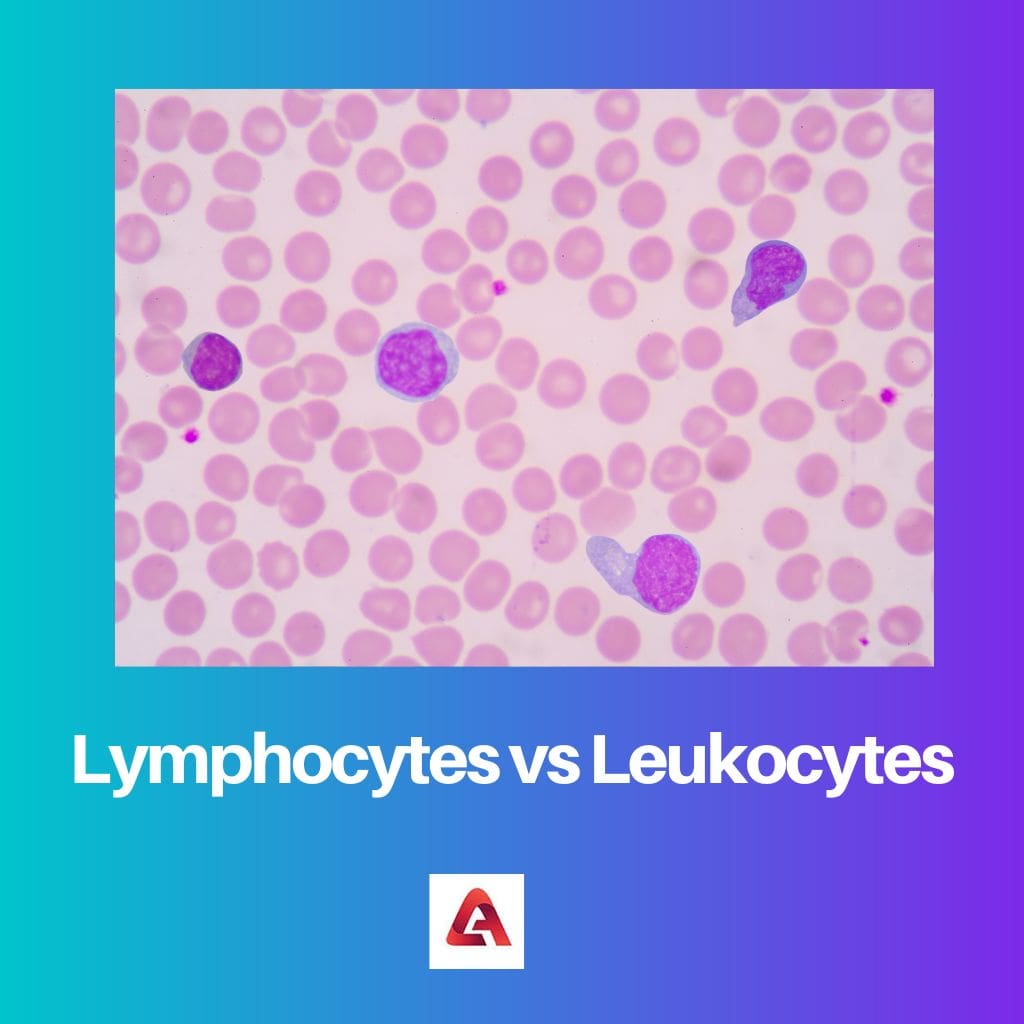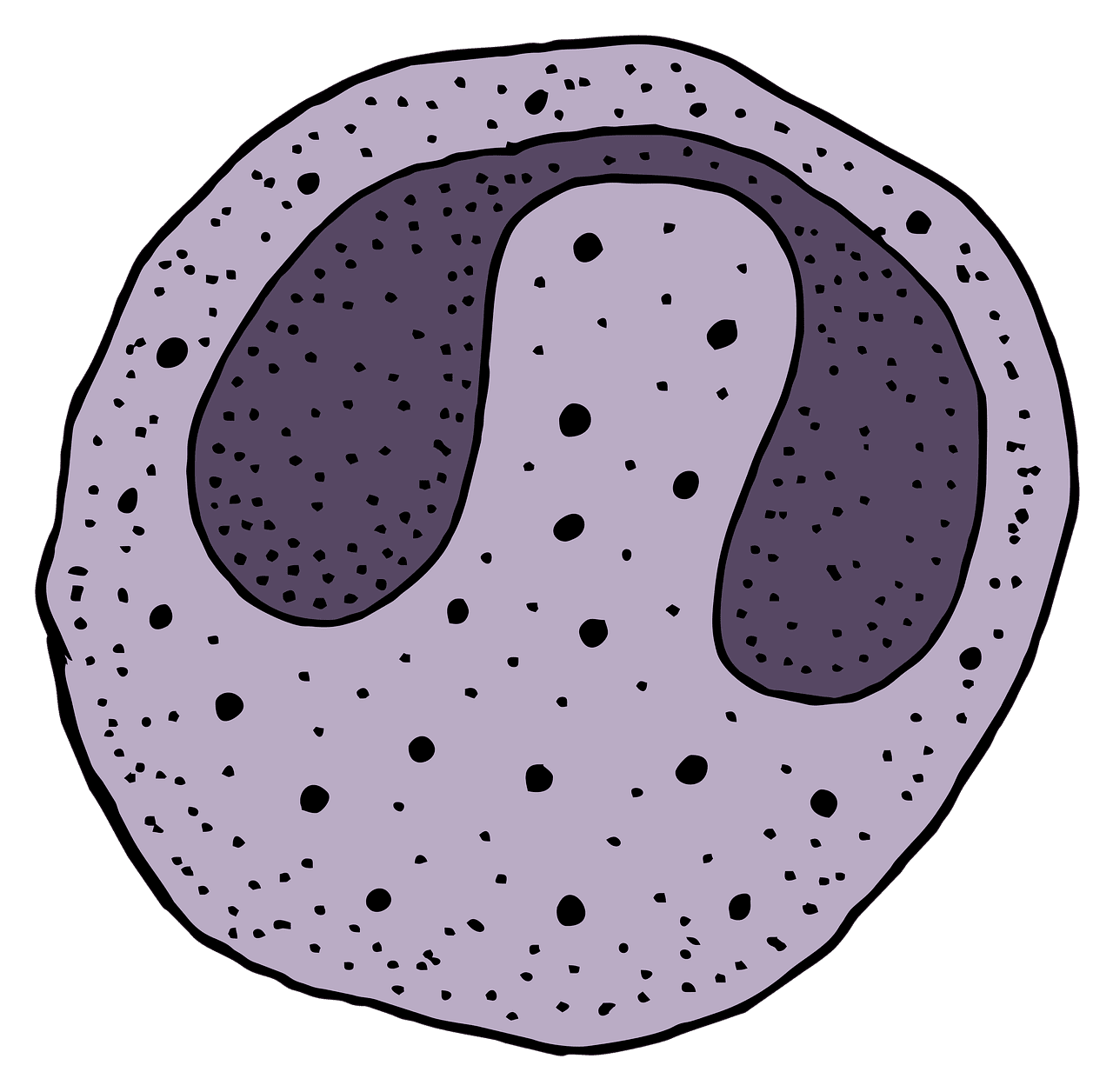Lymphocytes and leukocytes are both types of white blood cells crucial for immune function, yet they differ in their roles and origins. Lymphocytes, a subset of leukocytes, include T cells, B cells, and natural killer cells, primarily responsible for adaptive immunity, recognizing specific antigens and mounting targeted responses. On the other hand, leukocytes encompass various types of white blood cells, including lymphocytes, neutrophils, monocytes, eosinophils, and basophils, collectively working to defend the body against pathogens.
Key Takeaways
- Lymphocytes and leukocytes are white blood cells that play important roles in the immune system.
- Lymphocytes are responsible for targeted immunity, while leukocytes play a broader role in fighting infections.
- While leukocytes are more common in the blood, lymphocytes are mostly found in lymphatic tissues.
Lymphocytes vs. Leukocytes
Leukocytes are cells that help the body fight infection and disease. They can be further categorized into two main groups: granulocytes and agranulocytes. Lymphocytes are produced in the bone marrow and can be found in the blood, lymph nodes, and lymphatic tissue. There are three main types of lymphocytes: B cells, T cells, and natural killer cells.

A lymphocyte is a white blood cell made in bone and marrow and found in lymph tissue and blood.
It is part of an immune system with two main types B cells and T cells b cells can make antibodies that can attack viruses, bacteria, and toxins. T cells help to control the immune system and kill tumors.
A leukocyte is defined as a part of the immune system in a body that helps the body fight diseases and infections.
Some leukocytes are monocytes, lymphocytes (T and B cells, also known as WBC or white blood cells), and granulocytes (basophils, neutrophils, and eosinophils).
Comparison Table
| Feature | Lymphocytes | Leukocytes |
|---|---|---|
| Type | Specific type of white blood cell (WBC) | General term for all white blood cells |
| Proportion of WBCs | 20-40% | 1% – 40%, depending on the type of leukocyte |
| Function | Part of the adaptive immune system, specializing in recognizing and fighting specific pathogens | Part of the innate immune system, providing a general defense against various pathogens and foreign bodies |
| Subtypes | B cells, T cells, Natural Killer (NK) cells | Neutrophils, Eosinophils, Basophils, Monocytes, Lymphocytes |
| Granules | Absent (agranulocytes) | Present in some types (granulocytes), absent in others (agranulocytes) |
| Lifespan | Highly variable, some can live for years | Short lifespan, hours or days |
| Location | Lymph nodes, spleen, blood, and other tissues | Primarily in the blood, but also migrate to tissues during an immune response |
What are Lymphocytes?
Lymphocytes are a type of white blood cell (leukocyte) that plays a central role in the immune system, serving as a key component of both the innate and adaptive immune responses. They are derived from stem cells in the bone marrow and mature into several distinct subsets with specialized functions.
Types of Lymphocytes
- T Cells: T lymphocytes, or T cells, originate from precursor cells in the bone marrow and mature in the thymus gland, hence their name. There are several subtypes of T cells, including cytotoxic T cells, helper T cells, and regulatory T cells. Cytotoxic T cells are responsible for directly attacking and destroying infected or abnormal cells, while helper T cells assist other immune cells by secreting cytokines and coordinating the immune response. Regulatory T cells help maintain immune tolerance and prevent autoimmune reactions.
- B Cells: B lymphocytes, or B cells, also develop from stem cells in the bone marrow. They are responsible for producing antibodies (immunoglobulins) in response to specific antigens encountered by the immune system. Upon encountering an antigen, B cells differentiate into plasma cells, which secrete large quantities of antibodies targeted against the antigen. B cells also contribute to immune memory, providing long-lasting protection against recurrent infections.
- Natural Killer (NK) Cells: NK cells are a type of lymphocyte that plays a critical role in the innate immune response. Unlike T and B cells, NK cells do not require prior sensitization to recognize and eliminate infected or abnormal cells. Instead, they can directly target and kill virus-infected cells, tumor cells, and cells undergoing stress or transformation. NK cells play a vital role in immune surveillance and tumor immunosurveillance, helping to identify and eliminate abnormal cells before they proliferate.
Functions of Lymphocytes
- Antigen Recognition: Lymphocytes express unique antigen receptors (T cell receptors on T cells and immunoglobulins on B cells) that enable them to recognize and respond to specific antigens with high specificity.
- Immune Activation and Effector Functions: Upon encountering antigens, lymphocytes become activated and undergo clonal expansion, proliferating into effector cells capable of mounting targeted immune responses, such as cytokine secretion, antibody production, and cytotoxicity.
- Immunological Memory: Following resolution of an infection, a subset of lymphocytes persists as memory cells, providing rapid and enhanced responses upon re-exposure to the same antigen. This memory component is essential for long-term protection against recurrent infections and forms the basis of vaccination strategies.

What are Leukocytes?
Leukocytes, commonly known as white blood cells, are a crucial component of the immune system responsible for defending the body against infectious agents, foreign substances, and abnormal cells. They are produced in the bone marrow and circulate throughout the bloodstream and lymphatic system, patrolling various tissues and organs.
Types of Leukocytes
- Neutrophils: Neutrophils are the most abundant type of white blood cell and are the first responders to sites of infection or tissue damage. They are highly phagocytic, meaning they engulf and digest pathogens, cellular debris, and foreign particles. Neutrophils play a critical role in the innate immune response against bacterial and fungal infections.
- Monocytes: Monocytes are large, circulating white blood cells that differentiate into macrophages and dendritic cells when they migrate into tissues. Macrophages are scavenger cells capable of phagocytosis and antigen presentation, while dendritic cells specialize in capturing and presenting antigens to activate other immune cells, thus bridging innate and adaptive immunity.
- Eosinophils: Eosinophils are white blood cells primarily involved in combating parasitic infections and allergic reactions. They release toxic granules containing enzymes and proteins that target parasites, as well as participate in the regulation of allergic inflammation by releasing cytokines and other mediators.
- Basophils: Basophils are granulocytes containing large, dark-staining granules that release histamine and other inflammatory mediators in response to allergens and parasitic infections. They contribute to the initiation and regulation of allergic responses and play a role in defense against certain parasites.
- Lymphocytes: While lymphocytes are a subset of leukocytes, they have been discussed separately in detail. They include T cells, B cells, and natural killer (NK) cells, each with distinct roles in adaptive and innate immunity.
Functions of Leukocytes
- Phagocytosis: Phagocytic leukocytes such as neutrophils, monocytes, and macrophages engulf and digest pathogens, cellular debris, and foreign particles to eliminate potential threats and promote tissue repair.
- Antigen Presentation: Monocytes, macrophages, and dendritic cells capture and present antigens to lymphocytes, initiating adaptive immune responses and facilitating the recognition and elimination of pathogens.
- Cytokine Production: Various leukocytes secrete cytokines, signaling molecules that regulate immune responses by modulating cell activation, proliferation, migration, and differentiation.
- Inflammatory Response: Basophils, eosinophils, and certain subsets of T cells contribute to the initiation and regulation of inflammatory responses, including allergic reactions, tissue repair, and defense against parasites.

Main Differences Between Lymphocytes and Leukocytes
- Classification:
- Lymphocytes are a specific subset of leukocytes.
- Leukocytes encompass a broader range of white blood cells, including lymphocytes, neutrophils, monocytes, eosinophils, and basophils.
- Origin and Maturation:
- Lymphocytes originate from stem cells in the bone marrow and undergo maturation in primary lymphoid organs such as the thymus (T cells) and bone marrow (B cells).
- Other leukocytes also originate from bone marrow stem cells but may mature and differentiate in various tissues and organs throughout the body.
- Function:
- Lymphocytes primarily mediate adaptive immunity, recognizing specific antigens and mounting targeted immune responses.
- Other leukocytes participate in both innate and adaptive immunity, with functions including phagocytosis (neutrophils, monocytes, macrophages), antigen presentation (monocytes, macrophages, dendritic cells), and secretion of inflammatory mediators (eosinophils, basophils).
- Subtypes:
- Lymphocytes include T cells, B cells, and natural killer (NK) cells, each with distinct roles in adaptive and innate immunity.
- Leukocytes encompass various subsets with specialized functions, including phagocytes (neutrophils, monocytes, macrophages), granulocytes (eosinophils, basophils), and antigen-presenting cells (monocytes, macrophages, dendritic cells).
- Recognition Mechanisms:
- Lymphocytes possess unique antigen receptors (T cell receptors on T cells, immunoglobulins on B cells) that allow them to recognize specific antigens with high specificity.
- Other leukocytes recognize pathogens and foreign particles through pattern recognition receptors (PRRs) that detect conserved molecular patterns shared by broad classes of pathogens, such as bacterial cell wall components and viral nucleic acids.
- Effector Functions:
- Lymphocytes execute effector functions such as cytokine secretion, antibody production, and cytotoxicity in response to antigen stimulation.
- Other leukocytes perform effector functions including phagocytosis, release of inflammatory mediators, and antigen presentation to activate lymphocytes and coordinate immune responses.

- https://ashpublications.org/blood/article-abstract/23/6/811/37857
- https://www.sciencedirect.com/science/article/pii/S0032579119325052